Speech Financial System Stability – Some Current Observations

John F. Laker
Assistant Governor (Financial System)
Address to the University of Western Sydney Conference on
‘Emerging Financial Services in Asia-Pacific’
Sydney –
Introduction
It is a pleasure to accept the invitation of the University of Western Sydney to address its conference on ‘Emerging Financial Services in Asia-Pacific’. The range of papers presented to the conference are illustrative of the ever-growing sophistication and complexity of financial services, but the themes of the plenary sessions remind us that there are still major challenges to face in strengthening the broad ‘architecture’ of the financial system.
This conference is being held after a period of unprecedented turbulence in the global economy. Since the new century began, we have faced the weakest international economic conditions for many years, accompanied by the unwinding of the tech stock bubble and substantial corrections in major equity markets. We have witnessed, in rapid succession, three severe shocks: the terrorist attacks of 11 September; the failure of Enron; and Argentina's default on its sovereign debt. More recently, geopolitical uncertainties over Iraq and the Korean Peninsula have at times weighed heavily on market confidence.
Global developments such as these form a crucial backdrop to the setting of monetary policy in Australia. Equally, though, they form a crucial backdrop to a vital but less publicised role for the Reserve Bank – namely, its role in safeguarding the stability of the Australian financial system. This responsibility is as old as central banking itself. In our case it was reconfirmed, and given sharper focus, by the Australian Government in 1998 when it introduced landmark reforms in response to the Financial System Inquiry (the Wallis Committee).
The Reserve Bank's objective is to ensure that financial disturbances in any part of the financial system do not ultimately threaten the health of the Australian economy. Obviously, this objective is closely linked to the Reserve Bank's other policy objectives of low and stable inflation, a secure and efficient payments system and smoothly functioning financial markets. However, our activities go much further than that. We specifically monitor the health of the Australian financial system and we have developed a range of ‘macro-prudential’ or financial soundness indicators to assist us in this task. These indicators draw on aggregate financial and economic data that help gauge the strength of the financial system and provide early warning signals of potential vulnerabilities. The Reserve Bank does not monitor the financial condition of individual financial institutions – this is the preserve of the Australian Prudential Regulation Authority (APRA), although the two agencies do work closely together.
In my talk today, I would like to share with you some of the latest readings from these financial soundness indicators, and our general assessment of how the Australian financial system is faring.
The international environment
Although market sentiment now appears to be improving, the global environment over recent years has been a difficult one from a financial stability perspective. Uncertainty about economic recovery and a retreat by investors from risk-taking have combined to generate various signs of financial stress: credit spreads have been high and volatile, equity markets have been in sharp decline and the balance sheets of financial institutions have been under pressure in a number of countries. For all that, however, the global financial system has proven resilient.
The indicators on banking systems in major financial centres present a mixed view. Banks with strong retail franchises have performed reasonably well. The US banking system, in particular, has coped better than most, maintaining relatively high capital ratios and low levels of non performing assets; to strengthen their balance sheets, US banks have been reducing costs, curtailing their activities and seeking to improve the management and pricing of risks. The US banking index has outperformed the broader US equity market for some time. The story is a similar one for banking systems in the United Kingdom and some European countries.
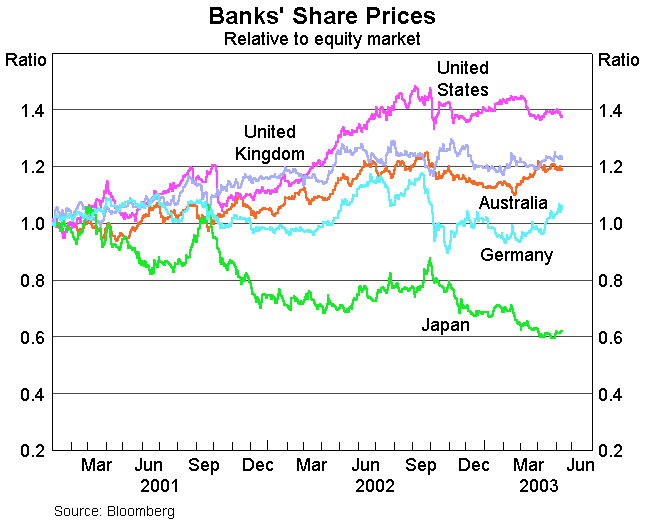
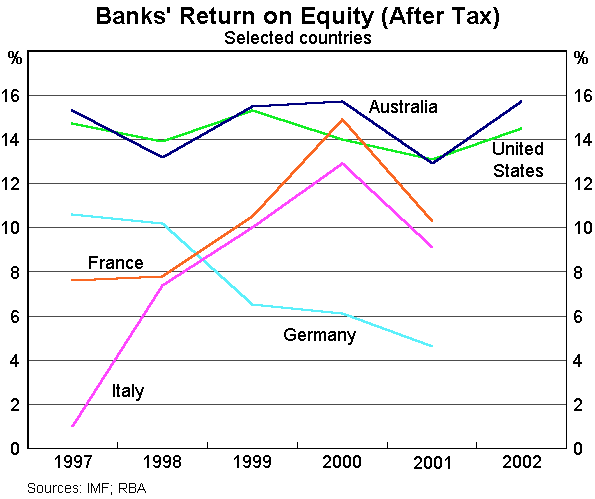
Clear areas of weakness have nonetheless emerged:
- banks that rely heavily on wholesale business have been under considerable pressure. Of the ten largest international banks, for example, seven have had their long-term rating downgraded by at least one of the major credit rating agencies in the past two years. Markets have heavily penalised those international banks which have suffered financial losses from lending activities, and reputational losses and legal liabilities from dubious business practices;
- larger banks in Germany have performed poorly. This has been a reflection of persistent economic weakness in Europe, structurally low profitability in banking and a rise in non performing loans. German supervisory authorities have twice over the past nine months felt the need to issue statements of support for German banks; and
- Japanese banks continue to labour under problems arising from deflation and the unwinding of Japan's earlier asset price bubble. The recognition and resolution of impaired asset problems continue to make only halting progress; the most recent official estimates suggest that some nine per cent of the total loans of Japanese banks are non-performing and private sector estimates are much higher.
The global insurance sector is a picture of a sector under stress. Weak equity and corporate bond markets and their effects on investment income explain much of the decline in the share prices of insurance companies at a global level, as well as the relative under-performance of European insurers. Life insurance companies in countries such as Germany, Switzerland and the United Kingdom have locked themselves into annuity products which depend heavily on equity returns exceeding guaranteed rates of return on policies, and these companies have been hard hit. They have responded to losses on investment portfolios by raising capital and reducing their equity holdings, while some supervisory authorities have provided leeway on equity valuation rules to reduce pressure to sell into declining markets. The global insurance sector plays a critical role in absorbing risk in the financial system – including, increasingly, as buyers of credit risk from banks through credit derivatives; for this reason, the financial condition of the sector and its future appetite for risk have become a major focus of international policy-makers.

Global economic and financial conditions impinge upon the Australian economy and Australian financial markets in a number of ways, which the Reserve Bank routinely analyses in the setting of monetary policy. From a financial stability perspective, our immediate concern is whether Australian financial institutions, particularly our internationally active banks, face risks of contagion from global developments. On the assets side of their balance sheets, Australian banks do have significant exposures to borrowers in overseas economies. These exposures have remained broadly constant over the last decade or so at – a little under one-third of total assets – but the mix has changed significantly. Lending to Japanese borrowers has diminished significantly in importance while lending to borrowers in New Zealand has risen to become the single largest country exposure, a little above the United Kingdom. The nature of risks facing Australian banks in their New Zealand and UK operations – where strong growth in mortgage lending has fuelled house price appreciation – bear close similarities with their exposures to Australian borrowers.
| 1990 | 1996 | 2002 | |
|---|---|---|---|
| New Zealand | 3.7 | 8.3 | 8.6 |
| United Kingdom | 8.3 | 7.1 | 8.0 |
| Euro Area | 2.8 | 2.5 | 4.4 |
| United States | 5.5 | 3.9 | 3.9 |
| Japan | 5.0 | 2.7 | 0.6 |
| Other | 4.6 | 5.1 | 5.3 |
| Total | 30.0 | 29.6 | 30.8 |
|
Source: APRA |
|||
On the liabilities side, Australian banks over the past few years have relied increasingly on borrowings in offshore wholesale markets to supplement their domestic deposit base. The major Australian banks now source around one-quarter of their liabilities offshore. There are no signs that recent global financial market volatility has had any impact on these funding programs. Australian banks carry only small net foreign exchange exposures on their offshore borrowings, which are either denominated in Australian dollars or largely hedged through the use of off-balance sheet transactions.
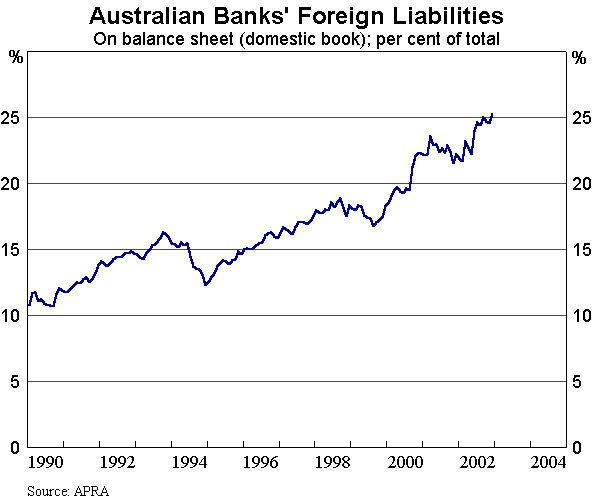
The Australian financial system
The risk profile of the Australian financial system has changed in important ways over the past few years. Traditionally, lending to the business sector has been the main source of credit risk for Australian financial institutions, and excessive lending in the ‘good times’ was a major contributor to previous episodes of financial instability. Over the past decade, however, growth in credit to households, particularly for housing, has outstripped lending to business and the household sector now has a higher level of debt than the business sector. These developments are due, in part, to the strength of corporate profits and positive share market sentiment over much of the period, which have enabled businesses to make greater use of internal funding and equity raisings for expansion. They also reflect strategic decisions by some major financial institutions to favour lending to households in the wake of their corporate loan loss experiences in the early 1990s. The divergent credit trends, which have continued in 2002/03, have resulted in a shift in the structure of assets held by financial intermediaries towards lower-risk loans. As a consequence, average credit quality has improved.
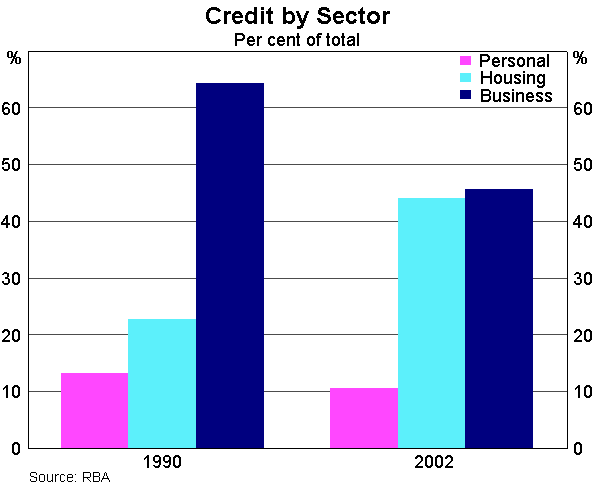
Business sector
Lending to the business sector currently accounts for around 45 per cent of total credit provided by Australian financial institutions. Latest readings confirm that the financial position of the business sector is sound. Corporate profitability remains high by historical standards, and although the drought has had an impact on rural producers, the profitability of other unincorporated enterprises is generally favourable compared with recent years. Debt levels are well below their peak of the late 1980s and interest burdens are at historically low levels. Credit spreads for low- and high-grade corporate debt have been narrowing, partly reflecting a decline in risk aversion by investors, and are now slightly below their historical averages. Credit ratings agencies have been sounding a more cautionary note about the outlook for credit quality, in line with expectations that growth in the Australian economy will slow somewhat over the course of this year.
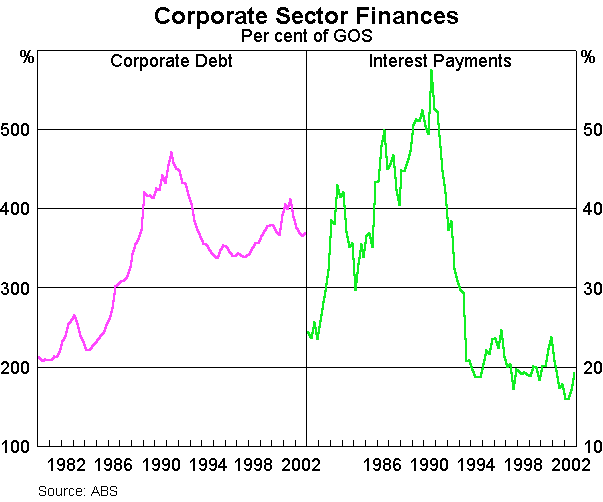
Within business lending, two sectors have been under somewhat closer scrutiny. The first is the rural sector, in view of the protracted drought which persists in many areas. Notwithstanding sharp falls in production and the impact on some rural communities, it is difficult to see the drought and its consequences as a threat to financial stability. Lending to the rural sector accounts for less than five per cent of total credit provided by banks. The interest burden of the rural sector is low both in historical terms and relative to other industries, and declines in revenue seem manageable in light of tax-effective savings instruments (such as Farm Management Deposits) and the previous run of good rural profits. The other sector is commercial property, where earlier episodes of over-investment taking its toll on the financial system come readily to mind. Conditions in the office property market deteriorated a little over 2001 and 2002, with the bursting of the high tech bubble and financial sector downsizing pushing up vacancy rates in some areas. Nonetheless, listed property trust prices remain well supported and current conditions appear to be better than those in the late 1980s: price rises over recent years have been far more muted and the build-up in supply has been much less pronounced. Banks have considerably reduced their exposures to office property to around three per cent of total bank credit (and to around 12 per cent for commercial property in general) and have gone to some lengths to strengthen their risk management procedures.
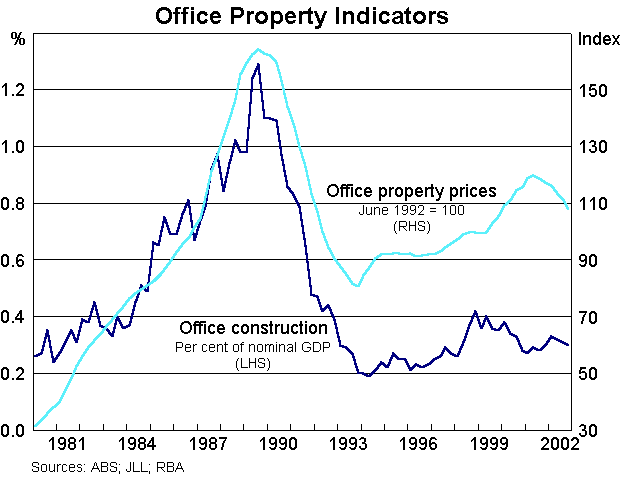
Household sector
Lending to the household sector currently accounts for around 55 per cent of total credit provided by Australian financial institutions. Around four-fifths of this lending is secured against housing and is provided mainly by the four major Australian banks.
Lending to households has been growing at strong double-digit annual rates for some time now, and the ratio of household debt to household disposable income has reached 125 per cent, in the upper part of the range of other comparable countries. The surge in lending has been associated with a sustained rise in residential property prices and, over more recent years, with a strong increase in demand for credit by property investors. As the Reserve Bank has said on other recent occasions, these developments have raised the financial risks facing that proportion of households (30 per cent) with housing debt, an issue to which I will return shortly. At this juncture, however, the indicators are not pointing to obvious signs of financial stress in the household sector. Interest rates remain at historically low levels and interest burdens – though on an upward trend – are below their peak in the late 1980s/early 1990s; many households have a significant cushion from repaying debt ahead of schedule (though others are topping up their debt through redraw facilities); and arrears on housing and other personal loans continue to breach cyclical lows. Solid growth in employment has continued to support household incomes and debt servicing capacity.

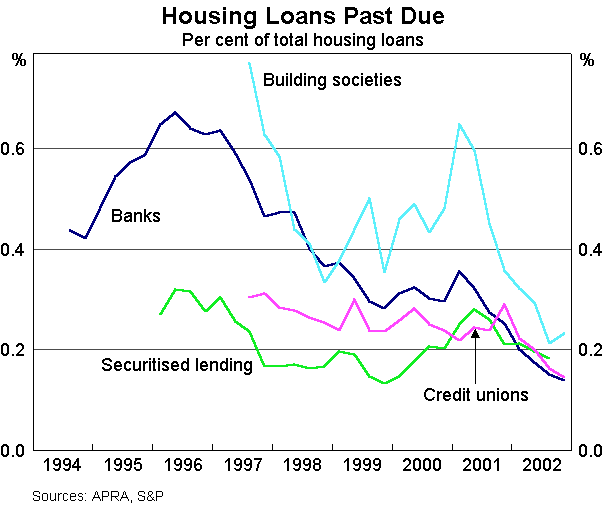
Financial intermediaries
Assessing the health of major groups of borrowers (the business and household sectors) is an essential element of the Reserve Bank's financial stability focus. In addition, of course, we monitor a range of financial soundness indicators to gauge the strength of financial institutions. These include indicators of asset quality, capitalisation, profitability and market valuation. The readings from these indicators continue to be reassuring.
Asset quality, for example, remains robust. For banks, the ratio of impaired assets to total assets was 0.6 per cent at end-March 2003, around the very low levels established during the course of the current economic expansion. ‘Distressed’ assets – a broader measure which includes loans on which payments are late (past due) – were 0.8 per cent of total assets. Impaired asset ratios are also at cyclical lows for building societies and credit unions. These measures of asset quality are, of course, backward looking and more forward-looking indicators strike a note of caution. A number of banks have noted potential for increased loan delinquencies in parts of their household and business exposures – including lending for investor housing – and some have tightened lending standards accordingly.

Financial intermediaries have strong lines of defence if there were to be any deterioration in credit quality. Banks hold general provisions of around 0.5 per cent of total assets against the possibility of future losses not attributable to particular assets. The ratio of specific provisions (written against assets already identified as impaired) to total assets is lower, reflecting the sustained improvement in asset quality over recent years. Banks maintain aggregate capital ratios of around 10 per cent of risk weighted assets, well above minimum required levels; the comparable ratios for building societies and credit unions are around 14–15 per cent.
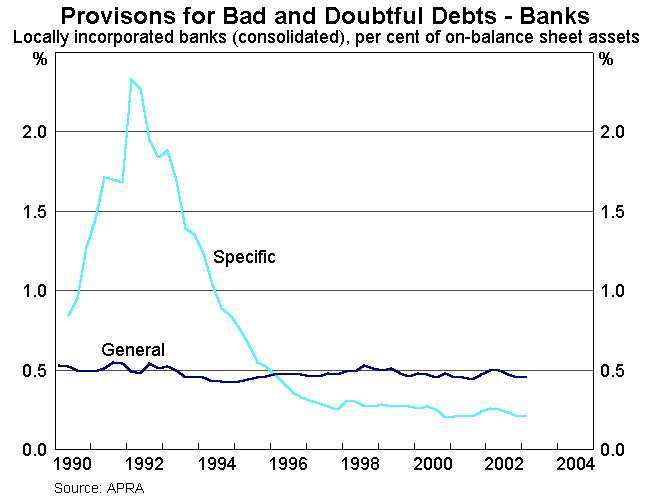
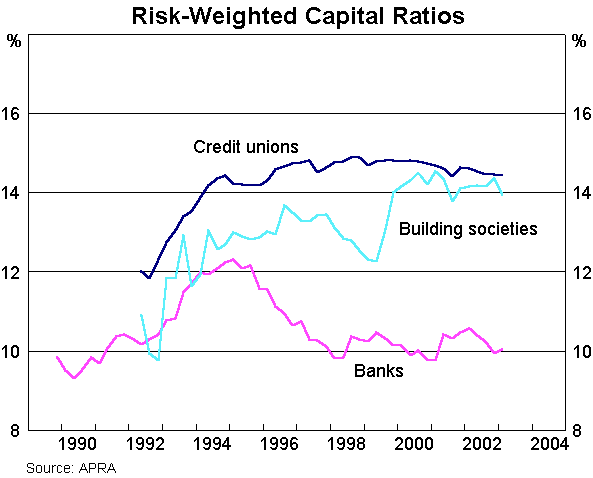
Notwithstanding the compression of interest margins over recent years, banks in particular have been able to maintain high levels of profitability as a result of significant asset growth, cost containment and diversification of income sources. For the major banks, non-interest income now accounts for almost half of total income, a share boosted by recent acquisitions of fund management businesses. Declining equity markets have been taking their toll on fund management activities but retail banking franchises remain strongly profitable.
Market indicators continue to signal a generally positive view of the credit quality of Australian banks. For example, despite recent setbacks, bank share prices have out-performed the broader market over a long period. Average spreads on long-term US dollar bonds issued (offshore) by Australian banks have regularly been lower and less volatile than the average spreads on comparable debt of their overseas counterparts.
Vulnerabilities in housing lending
Looking ahead, the main potential source of risk from a financial stability perspective would be a substantial correction in the housing market, impacting on the balance sheets of financial intermediaries through mortgage defaults. Lending for housing has continued to expand at a rapid pace and there are only tentative signs of an easing of pressure in the housing market. A flattening or modest reversal of house price increases would not in itself be a cause for concern. The concern would be a sharp jump in mortgage default rates which triggered a more substantial market correction – a scenario more likely to be associated with a deterioration in employment conditions or a sharp rise in interest rates.
In a recent address, the Governor of the Reserve Bank posed the question ‘Do Australian Households Borrow Too Much?’[1] The broad conclusion was that a proportion of households has clearly taken on more risk – in the Governor's words: ‘… I suspect that a significant number of households have chosen a debt level which makes sense in good times, but does not take into account the fact that bad times will inevitably occur at some time or other’. The Governor noted, in particular, the exceptionally fast increase in borrowing for property investment, and the accompanying rapid expansion in apartment building, which show all the signs of a seriously over-extended market.
The obverse to the Governor's question is ‘Do Australian Financial Institutions Lend Too Much to Households?’ The Governor opined that ‘[as] far as we can judge at this stage, the rise in household debt does not pose a significant danger of a financial crisis, i.e., the failure of significant financial institutions such as occurred in the early 1990s after the build-up in corporate debt’. My remaining remarks today outline some of the factors which have led us to this judgment.
Clearly, the general strength and profitability of financial intermediaries in Australia over a sustained period underpins our current assessment. However, we have also taken into account developments that are specific to housing lending. The first is the risk management procedures pursued by banks and other housing lenders, and the ‘internal buffers’ on which they may draw. The second is the extent to which risks on housing lending are being transferred from lenders to other risk-takers.
To guard against the risk of a significant increase in mortgage delinquencies, financial intermediaries apply various 'stress tests’ to their housing portfolio, looking at the impact of higher interest rates, rising unemployment and falling house prices on expected default rates and losses. A key benchmark in loan application processes is the capacity of the borrower to service increases in interest rates, normally taken to be two percentage points. For lending to investors, intermediaries generally make allowance for falling rental yields by assuming that the expected rental income is not received in full each year; some work on the assumption that the property is vacant for up to three months a year. Financial intermediaries have been strengthening their risk management capacities in housing lending (and other areas), and it is critical that they maintain their lending standards in these headier times. That said, APRA has recently found cause to voice concerns about slippages in property lending practices.
If default rates were to rise, lenders have two internal buffers to draw on: the value of equity supporting the housing loan – commonly measured as the loan-to-valuation ratio (LVR) – and the amount of excess repayments that borrowers have made at their discretion. Average LVRs appear to be around 50–60 per cent across lending portfolios but, of course, it is the more recent borrowers who will be highly leveraged. Even so, liaison suggests that the bulk of new housing loans made by the major banks have LVRs below 80 per cent. Recent household survey data suggests that about two-thirds of households with mortgage debt repay their housing loans ahead of schedule, and anecdotal evidence from banks puts the figure even higher. (Of course, this has been influenced by the fact that we have been in a falling interest rate environment.) On the other hand, an increasing number of households are now taking advantage of new lending products – such as home equity loans and redraw facilities – to top up their mortgages, ensuring that their debt levels remain higher for longer.
For housing loans with an LVR above 80 per cent, financial intermediaries generally have protection in the form of mortgage insurance. In the event of default on an insured loan, the lender receives any shortfall between the proceeds from the sale of the underlying security (collateral) and the amount of the loan outstanding from the mortgage insurer.
Recourse to mortgage insurance is supported by APRA's prudential guidelines. In order to qualify for the concessional 50 per cent risk-weight applied to housing loans for capital adequacy purposes, loans must either have an LVR less than 80 per cent or be covered by mortgage insurance. If this cover is to be relied on in hard times, mortgage insurers themselves need to be in a strong financial position, and APRA requires that they be at least A-rated. In determining credit ratings, ratings agencies require mortgage insurers to hold capital sufficient to cover a number of ‘worse-case scenarios’, including a prolonged downturn in the economy and substantial falls in house prices. To achieve the highest rating, a mortgage insurer would need to be able to withstand an increase in insurance claims that was many times more than the worst historical claims experience.
Mortgage insurance acts as an important form of risk transfer for financial intermediaries: in essence, the credit risk of insured loans is transferred from their balance sheets onto the balance sheets of highly rated mortgage insurers. The proviso is that intermediaries must be able to satisfy mortgage insurers that they have complied fully with all aspects of the underlying insurance contract. These contracts may have strict conditions on the reporting of arrears which may be easy to satisfy when the volume of delinquencies is low, but less so when default rates are increasing sharply. APRA is currently giving this operational risk close attention.
Financial intermediaries also use the securitisation market as a means of shedding credit risk on housing lending. While the majority of housing debt remains on the books of the intermediaries, an increasing proportion of housing loans is being securitised by both lenders and mortgage managers. Since the mid-1990s, securitised mortgages have risen from $5 billion or three per cent of housing debt, to around $75 billion or 17 per cent of housing debt.
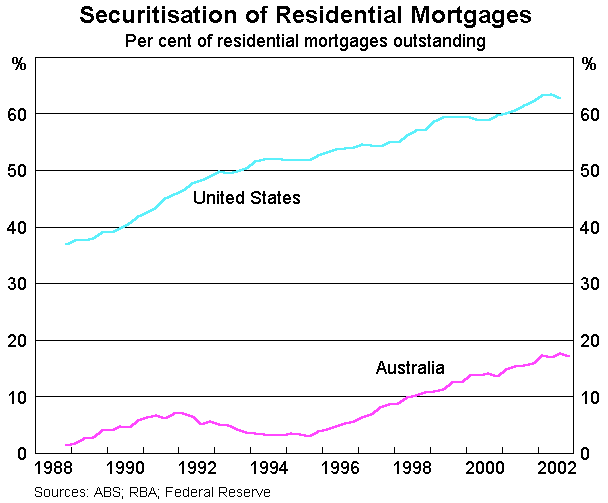
By dispersing credit risk over a wider investor base, rather than allowing it to become concentrated on the balance sheets of a small number of financial institutions, securitisation has the potential to reduce threats to financial stability. At the same time, securitisation can introduce other forms of risks if the end-investor lacks the capacity to manage or absorb credit risk, particularly as deals become more complex. This does not appear to be a particular concern with the residential mortgage-backed securities (RMBS) market in Australia. The majority of RMBS deals are backed by prime, fully insured mortgages and, over time, their performance has typically compared favourably with the mortgages retained on the books of financial institutions. As a result, the senior tranche of RMBS issues is generally rated AAA and the subordinated tranches, which usually cover no more than five per cent of the securities issued, typically carry investment-grade ratings.
Financial intermediaries need to be careful to ensure that securitisation does not substitute other forms of risk for credit risk. APRA's prudential guidelines require authorised deposit-taking institutions to hold adequate capital against any exposures arising; to have systems in place to identify, monitor and control the risks associated with securitisation; and make clear disclosures about risk to investors.
A more recent development in the dispersion of credit risk on housing lending is the emergence of ‘non-conforming’ mortgage managers, through which borrowers who do not meet standard lending criteria can gain access to housing finance that might not otherwise be available. The non-conforming loan market in Australia is still only small in overall size (some estimates put it at around four to six per cent of housing loans written) but it is growing strongly. The rate of arrears on non-conforming loans appears to be much higher than the rate on housing lending by traditional lenders.
Does the growth of this market raise any particular concerns from a financial stability perspective? Banks fund some of the origination and warehousing of these mortgages prior to securitisation and so carry some exposure to non-conforming lenders. However, the exposure is only for a limited period and is secured against residential property. There may be a less direct impact on financial stability, however, via house prices. At this stage of the cycle, the growth in the non-conforming loan market is adding to demand pressures in the housing market. If economic conditions were to change, however, marginal borrowers are likely to be more vulnerable and one might expect them to quickly become distressed sellers in adverse circumstances. In this way, the non-conforming loan market might become a source of additional cyclicality in house prices.
Concluding comments
Over the past couple of years, the global financial system has been buffeted by a number of pressures and some unprecedented shocks. Nonetheless, the system has continued to prove resilient and financial stability has been maintained. Banking systems, generally speaking, are well capitalised but potential fault lines have emerged in the global insurance sector which are receiving close scrutiny by policy makers. Recent developments have also exposed weaknesses in the financial architecture – in corporate governance, accounting and auditing standards in particular – which demand and are receiving international attention.
The Australian financial system is not quarantined from global developments but our judgment is that it remains in strong condition, underpinned by the continued expansion of the Australian economy. Looking ahead, the cloud on the near horizon is the substantial build-up in household debt, which may create strains for financial institutions if Australia's economic circumstances were to deteriorate and mortgage defaults rise sharply. In this setting, the use of probabilities of default derived from previous credit cycles to assess and manage credit risk on mortgage lending may understate the risks being built up. Nonetheless, the ‘buffers’ available, and the redistribution of credit risk taking place, provide reassurance that the financial system has the capacity to cope with any substantial housing market correction. Individual financial institutions which lower their guard could obviously come under pressure, but a substantial correction is less likely to generate a systemic shock that would threaten overall financial stability.
Endnote
Address by Mr I.J. Macfarlane, Governor, to The Sydney Institute, Sydney, 3 April 2003, reproduced in RBA Bulletin, April 2003. [1]